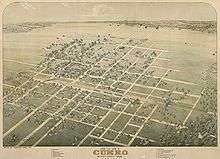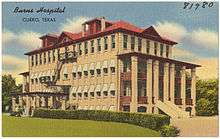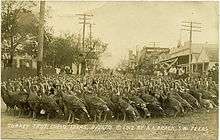Cuero, Texas
| Cuero, Texas | |
|---|---|
| City | |
|
Cuero Commercial Historic District | |
| Motto: History, Heritage, Hospitality | |
|
Location of Cuero, Texas | |
 | |
| Coordinates: 29°5′37″N 97°17′28″W / 29.09361°N 97.29111°WCoordinates: 29°5′37″N 97°17′28″W / 29.09361°N 97.29111°W | |
| Country | United States |
| State | Texas |
| County | DeWitt |
| Area | |
| • Total | 4.9 sq mi (12.8 km2) |
| • Land | 4.9 sq mi (12.8 km2) |
| • Water | 0.0 sq mi (0.0 km2) |
| Elevation | 184 ft (56 m) |
| Population (2010) | |
| • Total | 6,841 |
| • Density | 1,386/sq mi (535.0/km2) |
| Time zone | Central (CST) (UTC-6) |
| • Summer (DST) | CDT (UTC-5) |
| ZIP code | 77954 |
| Area code(s) | 361 |
| FIPS code | 48-18092[1] |
| GNIS feature ID | 1377543[2] |
| Website |
www |
Cuero (/ˈkwɛroʊ/ KWAIR-oh[3]) is a city in DeWitt County, Texas, United States. The population was 6,841 at the 2010 census.[4] It is the county seat of DeWitt County.[5] It is unofficially known as the "turkey capital of the world" (this is reflected in the Cuero High School mascot, the Gobblers). In 2010, Cuero was named one of the "Coolest Small Towns in America" by Budget Travel magazine.[6]
History
The city of Cuero had its start in the mid-19th century as a stopping point on the Chisholm Trail cattle route to Kansas. However, it was not recognized as a town until 1873, when it was officially founded. The city was named for the Spanish word meaning "hide", referring to the leather made from animal hides. The industry was extremely short-lived, however, and gave way to various forms of ranching. The city had several Old West gunfights related to clan feuding following the Civil War
Cuero's population grew considerably in the 1870s and 1880s, as residents from the coastal town of Indianola, Texas, settled here after major hurricanes in this period destroyed sizeable portions of that city. Cuero thrived through much of the late 19th and early 20th centuries by the introduction and practice of turkey ranching in the area. Today, agriculture is still the primary industry in the region. Cuero is considered to be one of the top cattle producers and shippers in Texas.
Geography
Cuero is located east of the center of DeWitt County near the mouth of Sandies Creek, where it empties into the Guadalupe River.
U.S. Routes 87, 77 Alternate, and 183 pass through the city. All three highways follow South Esplanade Street into the center of town; US 87 then leaves town via East Broadway Street, while US 77A and 183 continue north out of town on North Esplanade Street. US 87 leads southeast 28 miles (45 km) to Victoria and west 87 miles (140 km) to San Antonio. US 77 Alternate leads northeast 16 miles (26 km) to Yoakum, and US 183 leads north 32 miles (51 km) to Gonzales. 77 Alternate and 183 together lead south 31 miles (50 km) to Goliad.
According to the United States Census Bureau, Cuero has a total area of 4.9 square miles (12.8 km2), of which 0.02 square miles (0.05 km2), or 0.36%, is water.[4]
Climate
The climate in this area is characterized by hot, humid summers and generally mild to cool winters. According to the Köppen Climate Classification system, Cuero has a humid subtropical climate, abbreviated "Cfa" on climate maps. Cuero has an annual average precipitation of 38.0 inches (965.2 mm), all rain, as snow is negligible in the area.[7]
Demographics
| Historical population | |||
|---|---|---|---|
| Census | Pop. | %± | |
| 1880 | 1,333 | — | |
| 1890 | 2,442 | 83.2% | |
| 1900 | 3,422 | 40.1% | |
| 1910 | 3,109 | −9.1% | |
| 1920 | 3,671 | 18.1% | |
| 1930 | 4,672 | 27.3% | |
| 1940 | 5,474 | 17.2% | |
| 1950 | 7,498 | 37.0% | |
| 1960 | 7,338 | −2.1% | |
| 1970 | 6,956 | −5.2% | |
| 1980 | 7,124 | 2.4% | |
| 1990 | 6,700 | −6.0% | |
| 2000 | 6,571 | −1.9% | |
| 2010 | 6,841 | 4.1% | |
| Est. 2015 | 7,115 | [8] | 4.0% |



As of the census[1] of 2000, 6,571 people, 2,500 households, and 1,695 families resided in the city. The population density was 1,331.1 people per square mile (513.6/km²). There were 2,867 housing units at an average density of 580.8 per square mile (224.1/km²). The racial makeup of the city was 67.25% White, 16.71% African American, 0.61% Native American, 0.52% Asian, 12.84% from other races, and 2.07% from two or more races. Hispanics or Latinos of any race were 34.73% of the population.
Of the 2,500 households, 33.0% had children under the age of 18 living with them, 47.2% were married couples living together, 16.0% had a female householder with no husband present, and 32.2% were not families. About 29.2% of all households were made up of individuals, and 16.6% had someone living alone who was 65 years of age or older. The average household size was 2.54 and the average family size was 3.13.
In the city, the population was distributed as 27.1% under the age of 18, 8.5% from 18 to 24, 24.4% from 25 to 44, 20.3% from 45 to 64, and 19.7% who were 65 years of age or older. The median age was 38 years. For every 100 females, there were 86.1 males. For every 100 females age 18 and over, there were 80.6 males.
The median income for a household in the city was $24,931, and for a family was $29,500. Males had a median income of $26,154 versus $16,551 for females. The per capita income for the city was $14,286. About 21.5% of families and 26.8% of the population were below the poverty line, including 34.6% of those under age 18 and 20.1% of those age 65 or over.
Arts and culture
Turkey Fest is a local festival during which the townsfolk compete with people at various turkey-centric events. The competitions revolve around the turkeys each town raises and in which each takes immense pride. The events are the prettiest turkey contest, turkey toss, turkey trot, and turkey race. Unlike most turkey trots, where humans do the racing, in Cuero, the "turkey trot" involves racing actual turkeys.
In 1972, Charles Kuralt did an "On the Road" Report for CBS News from Cuero, where he did his own turkey call.
"Christmas in Cuero" began in 2000 with the lighting of the gazebo in Cuero Municipal Park. It has grown to over 100 displays of Victorian and Western scenes, 12-car trains, gingerbread houses, and other scenes. A live nativity scene is sponsored by a church in Cuero. Two of the scenes were vandalized by two teens in November 2009. The park was still open to the public excluding the two damaged scenes. The teens arrested for the crime had their bonds set at $150,000, in part because of the effect the crime had on the community.[10]
Parks and recreation
Cuero has many places for recreation, including a baseball complex, a golf course, volleyball courts, tennis courts, a basketball pavilion, and a park area with access to public swimming pool.
Education
The City of Cuero is served by the Cuero Independent School District. John C. French serves PK-K grades, Hunt Elementary serves grades 1–3, Cuero Intermediate School serves grades 4–6, Cuero Junior High serves grades 7–8, and Cuero High School serves grades 9–12.
In addition, the City of Cuero is served by St. Michael's Catholic School. Providing education for the children of DeWitt County for over 130 years, the school has a fully accredited early childhood program (PreK-3 and PreK-4) and offers quality education for grades K-6.
Notable people
- Frank Bass, professor and inventor of the Bass diffusion model
- MSG Roy Benavidez, Medal of Honor recipient
- Leo Frank, lynching victim
- Fred Hansen, Olympic champion pole vaulter
- Frank Horton (New York politician)
- Caesar Kleberg, conservationist
- Jo Morrow, actress
- Sam Neely (1948-2006), country/folk musician and writer
- Aurora Estrada Orozco (1918–2011), Mexican American community leader
- Robert Strait, high school football running back
- Cody Wallace, NFL player
- Arthur Whittington, NFL player
See also
References
- 1 2 "American FactFinder". United States Census Bureau. Archived from the original on 2013-09-11. Retrieved 2008-01-31.
- ↑ "US Board on Geographic Names". United States Geological Survey. 2007-10-25. Retrieved 2008-01-31.
- ↑ Say it Like a Texan TexasTripper.com.
- 1 2 "Geographic Identifiers: 2010 Demographic Profile Data (G001): Cuero city, Texas". American Factfinder. U.S. Census Bureau. Retrieved January 7, 2016.
- ↑ "Find a County". National Association of Counties. Archived from the original on 2011-05-31. Retrieved 2011-06-07.
- ↑ "Photos: Coolest Small Towns in America" BudgetTravel September 2011.
- ↑ Climate Summary for Cuero, Texas
- ↑ "Annual Estimates of the Resident Population for Incorporated Places: April 1, 2010 to July 1, 2015". Retrieved July 2, 2016.
- ↑ "Census of Population and Housing". Census.gov. Archived from the original on May 11, 2015. Retrieved June 4, 2015.
- ↑
External links
| Wikimedia Commons has media related to Cuero, Texas. |

